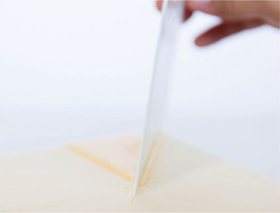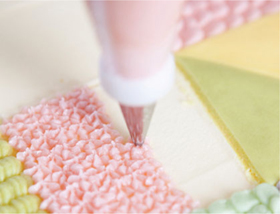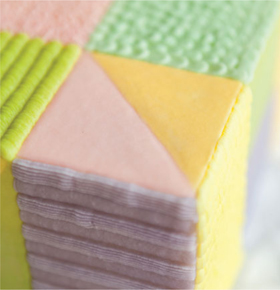
Simple squares can create a very contemporary look, particularly when you restrict them to a delicate pastel palette. Keep your squares perfectly square and be accurate with your piping otherwise the effect won’t be as good. We’ve used a different colour combination or texture for each square, mixing the simple and the more intricate. The pale shades enhance the perfection of each square.


1. Stack and crumb coat your cake (see Buttercream Basics). Cut a square of baking (parchment) paper the same size as the top of the cake. Fold it to divide the paper into nine small equal squares.

2. Cut one column of the guide paper and position it on the top of the cake. Use a scraper or ruler to mark out three columns.
You can use all sorts of other piping techniques to fill the designs for each patch – scrolls, criss-crosses, dots, small piped flowers or anything else you can think of.

3. Repeat the process to mark the rows. Do the same on the sides of the cake as well.

4. Divide some squares into two, either into rectangles or triangles, using either a scraper or a small piece of cardboard. Apply any choice of tinted buttercream and even it out with the palette knife or the cardboard.

5. Smooth the triangles and rectangles with a non-woven cloth and scraper (see Buttercream Basics).

6. Trim the sides of the shapes in order to make them really straight. Use a scraper, press down and pull it away from the patch. With the edges straight you can repeat steps 4–6 to fill in the other halves of the patches with another colour.

7. If the patch is on the corner edge of the cake, use a scraper and cut downwards. Fill the remaining patches with a variety of colours and textures by swapping the nozzles between different colours of buttercream.

8. When piping the shell design, start from the outer edge using the Wilton plain round nozzle 5. Hold the piping bag at about an 80-degree angle with the opening of the nozzle touching the surface, squeeze until the buttercream builds up then pull the nozzle down.

9. When using the chrysanthemum nozzle, make sure the curved part is facing upwards while the two points face down and touch the surface. Start at one end and continuously squeeze the piping bag with an even pressure as you move your hand in a tight back and forth movement to give an even texture.

10. To fill a patch with small stars, start at one end then hold the piping bag at a 90-degree angle with the opening of the nozzle touching the surface, and gently give the bag a good squeeze until it creates a small star. Repeat the same process and make sure you pipe the stars very close together (but not actually overlapping) so that there are no gaps in between.

11. To fill a patch using the basketweave nozzle, start at one end choosing either of the sides of the nozzle. Squeeze the piping bag with constant pressure and slowly pull the piping bag down or away. Flip the bag over to pipe alternate stripes of the jagged side of the nozzle and the smooth side.
This design is very flexible and can be used to create a cake for both men and women. Explore the use of other nozzles and colour combinations to suit your occasion – imagine using gradient colours of pink or blue, it would look amazing! You can also be playful with the shapes. You don’t always have to have square patches.

